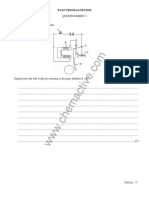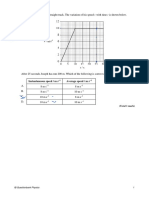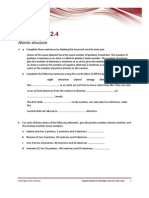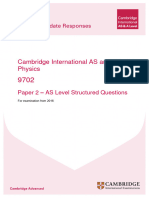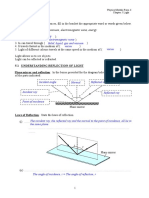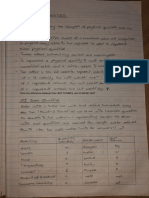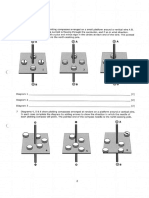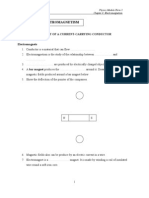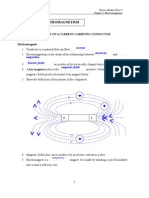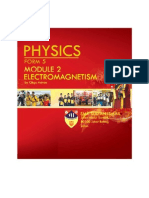SPM Physics Form 5
Uploaded by
Woody CysSPM Physics Form 5
Uploaded by
Woody CysJPN Pahang Teachers Guide
Physics Module Form 5 Chapter 8: Electromagnetism
CHAPTER 8: ELECTROMAGNETISM
8.1: MAGNETIC EFFECT OF A CURRENT-CARRYING CONDUCTOR
Electromagnets 1. Conductor is a material that can flow .. 2. Electromagnetism is the study of the relationship between .and .. 3. . are produced by electrically charged objects. 4. A bar magnet produces the around it. Draw the pattern of the magnetic fields produced around a bar magnet below 5. Show the deflection of the pointer of the compasses.
6. Magnetic fields also can be produce by an electric current in a wire. 7. Electromagnet is a magnet. It is made by winding a coil of insulated wire round a soft iron core.
JPN Pahang Teachers Guide
Physics Module Form 5 Chapter 8: Electromagnetism
8. Using the diagram, complete the steps to switch on the magnetism effect.
Soft iron core switch Insulated wire switch
Soft iron core
DC supply
DC supply
Insulated wire
pins
pins
Switch is closed
Magnetic Field due to a Current in Straight Wire 1. Using Right-hand Grip Rule, draw the direction of current flows and pattern of magnetic fields formed
2. Right-hand Grip Rule states that the thumb of the right hand points to the direction of
current flow and the other four curled fingers points to direction of its .
JPN Pahang Teachers Guide
Physics Module Form 5 Chapter 8: Electromagnetism
3. Draw the same patterns from the top views as follows together with the direction shown by the compasses.
Means that a wire carrying current .. the plane of paper Means that a wire carrying current ... of the plane of paper
Exercise 8.1 1. Two small plotting compasses P and Q are placed near a long straight wire carrying a current as shown. P Q
Show the directions shown by the pointers of the compasses
JPN Pahang Teachers Guide
Physics Module Form 5 Chapter 8: Electromagnetism
4. In the diagram below, the compasses are put under the conductor. Can you draw the direction shown by compasses and what happen if the compasses are put on the conductor?
The compass is put UNDER the conductor
The compass is put UNDER the conductor
Magnetic Field due to a Current in a Circular Coil 5. Draw the direction of current flows and pattern of magnetic fields formed. 6. The direction of magnetic field also can be determined using the RightHand Grip Rule.
* Notes:
JPN Pahang Teachers Guide
Physics Module Form 5 Chapter 8: Electromagnetism
Magnetic Field due to a Current in a Solenoid 7. Solenoid is combination of coils of wire wounded around on some surface or wounded around an iron core. 8. Draw the direction of current flows, pattern of magnetic fields formed and direction by the compasses. 9. To check the poles formed, see from beside of the solenoid. If the current flow is clockwise, the polarity on that side is but, if the current flow is anti-clockwise, the polarity on that side is
Factors that affects the strength of an electromagnet 10. To study this, we need to carry out experiments as follows. The higher the number of paper clips attracted to the solenoid shows the ...the strength of that electromagnet.
Cell Rheostat Iron core Paper clips
JPN Pahang Teachers Guide
Physics Module Form 5 Chapter 8: Electromagnetism
Manipulated Number of turns
Responding Number of paper clips attracted
Fixed Current, types of core Number of turns, types of core
Types of core
Number of paper clips attracted
Factors that affects the strength of an electromagnet 11. As a conclusion, fill the table below Factors Number of turns Electric current Use of normal iron-core Use of soft-iron core -nilConditions Number of paper clips attracted Affects on the strength of electromagnetic fields
Applications of Electromagnet 12. There are many applications of electromagnets. Label and describe the figure of each apparatus stated in the table below with its simple work-frame. 1) Electric bells switch 1. 2. 3.
4. 5.
JPN Pahang Teachers Guide
Physics Module Form 5 Chapter 8: Electromagnetism
2) Electromagnetic Relays
1.
2. 3. 4.
to
3) Telephone earpieces//speakers 1. 2.
3.
4. 5.
JPN Pahang Teachers Guide
Physics Module Form 5 Chapter 8: Electromagnetism
4) Circuit breakers Its operate as 1.
2. 3. 4.
from
to
5) Lifting Magnet Its function to 1. 2.
3. 4.
5.
JPN Pahang Teachers Guide
Physics Module Form 5 Chapter 8: Electromagnetism
Exercise 8.1.2 1. A magnetic field is produced by the current in a long straight wire. The strength of the magnetic field increases if. A B C The magnitude of the current increases The distance from the wire increases The length of the wire increases
2. Which of the following is true about the magnetic field produced by a current in a flat circular coil?. A B C D It is uniform inside the coil It is the weakest at the centre It is the strongest at the centre There is no magnetic field outside the coil
3. What is the effect of placing a piece of soft iron core inside a solenoid carrying current? A B C The resistance of the solenoid decreases The current in the solenoid increases The magnetic field becomes stronger
4. An electromagnet is used in these apparatus except A B C D a compass an a.c dynamo a moving coil ammeter a telephone earpiece
5. Which electromagnet is the strongest? A B C D
+2V-
+2V-
+4V-
+4V-
JPN Pahang Teachers Guide
Physics Module Form 5 Chapter 8: Electromagnetism
8.2: Force Acting on a Current-carrying Conductor in a Magnetic Fields 1. If a current-carrying conductor is placed in a magnetic fields as shown in the experiment, the conductor will experiences a ..
Magnet C-Shape iron
Freely conductor Long conductor
Power Supply
2. Draw the combination (called catapult field) of two electromagnetic fields below and show the direction of movement of the conductor.
3. Flemings left-hand rule can be use to determine the direction of the force acting or the motion of the conductor.
First Finger (
Thumb (
)
N
Centre Finger (
10
JPN Pahang Teachers Guide
Physics Module Form 5 Chapter 8: Electromagnetism
Effect of Two Parallel Current-carrying Coils in a Magnetic Field 4. If two current-carrying conductor is placed in a magnetic fields as shown in the experiment, the conductor will experience or .. force between them. 5. Complete the diagram for current with opposite direction flows in two parallel conductor below:
The two conductor will .. to each other 6. Complete the diagram for current with same direction flows in two parallel conductor below:
The two conductor will .. to each other 11
JPN Pahang Teachers Guide
Physics Module Form 5 Chapter 8: Electromagnetism
Turning Effect of a Current-carrying Coil in a Magnetic Field 7. Consider a current-carrying coil ABCD placed between the poles magnet as shown in the figure below. 8. As the current flows through the coil from A to D, an ... (1) force acts on the arm CD whereas a (3) force acts on the arms AB according to Flemings Left Hand rule. N Coil S B 2 3 Magnet current D C
1 4 A
9. Draw the catapult filed formed and draw arrows to show the movement of arms AB and CD.
AB
CD
12
JPN Pahang Teachers Guide
Physics Module Form 5 Chapter 8: Electromagnetism
Direct Current Motor 10. Complete the four stages of the motion of DC motor below
Coil
S
A
current
1 B 3 2 D
Degree : Current flow : Yes / No ... Arm AB : . Arm CD : Rotation : .
N S
Degree : Current flow : Yes / No ..... Arm AB : .
current
Arm CD : Rotation : .
N S
Degree : Current flow : Yes / No ..... Arm AB : .
current
Arm CD : Rotation : 13
JPN Pahang Teachers Guide
Physics Module Form 5 Chapter 8: Electromagnetism
Coil
S
Degree : Current flow : Yes / No .....
current
Arm AB : . Arm CD : Rotation : .
Comparison with Alternating Current Motor 11. Complete the diagram of AC motor below:
a.c supply
14
JPN Pahang Teachers Guide
Physics Module Form 5 Chapter 8: Electromagnetism
Factors that affect the speed of rotation of an electric motor 12. The magnitude of force acting on a conductor in a magnetic increases by: i. Increasing the current flow ii. Stronger magnet used 13. In conclusion, the speed of rotation of the coil also can increased by: i. ii. iii. .
Moving Coil Ammeter
15
JPN Pahang Teachers Guide
Physics Module Form 5 Chapter 8: Electromagnetism
Exercise 8.2 1. The motion of a conductor carrying current in an magnetic fields can be determine by A Right hand Grip Rule B Flemings Right Hand Rule C Flemings Left Hand Rule D Direction of current flow 2. N A B C A current carrying wire is in between the poles of a magnet. The direction of the force on the wire is A North South B D East West C 6. Choose the best pattern formed. A B C 4. The function of the commutator in a d.c. motor is to reverse the current in the coil at to enable the coil to be in electrical to prevent the wires from entangling 5. A moving coil-ammeter is less sensitive if N S the hair spring is harder the magnet is stronger the scale is shorter every half rotation contact with carbon brushes
3. Two parallel wires are carrying equal currents in opposite directions. Which diagram shows the forces F on the wires? A B F F C F F F D F F F
16
JPN Pahang Teachers Guide
Physics Module Form 5 Chapter 8: Electromagnetism
8.3: Electromagnetic Induction 1. As we know, a steady magnetic field can be produced by a or . 2. When we move a coil without any current flow is in a magnetic field, an induced e.m.f (electromotive force) is produced. 3. An flows through the conductor and this phenomenon called 4. So, electromagnetic induction requires relative motion between magnet and the coil to produce an induced current. 5. Complete the table below as experiment data for the diagram below:
Induced e.m.f by a moving conductor
Action The wire is moved upwards The wire is moved downwards The wire is move horizontally Magnet is moved upwards
Obseravtion Galvanometer deflect to left
Inference
No current flows
17
JPN Pahang Teachers Guide
Physics Module Form 5 Chapter 8: Electromagnetism
6. Flemings Right-hand rule can be use to determine the direction of the induction current produced. Thumb ( )
First finger (
Center finger (
Induced e.m.f by coil
18
JPN Pahang Teachers Guide
Physics Module Form 5 Chapter 8: Electromagnetism
Lenzs Law 7. Lenzs Law also can be use to determine the direction of induced current produced. 8. Lenzs Law states that the direction of the induced e.m.f is such that its magnetic effects always .the change producing.
When the N pole is moved towards the coil, end of coil becomes
When the N pole moved away from the coil, end of coil becomes
Faradays Law of electromagnetic induction 9. Faradays Law states that the magnitude of the induced e.m.f. is .. to the rate of change of magnetic flux experienced by the conductor. 10. The magnitude of the e.m.f in a wire increases when: i. ii. . iii. ... 11. The magnitude of the e.m.f in a coil/solenoid increases when: i. . ii. . iii. ....
19
JPN Pahang Teachers Guide
Physics Module Form 5 Chapter 8: Electromagnetism
Applications of electromagnetic induction 12. A generator is basically the inverse of a motor. There are many coils of wire wound that can rotate in a magnetic field. The axle is turned by some mechanical such as .., . or wind turbine. 13. The dc generator and ac generator make use of electromagnetic induction to produce
DC Generator
Handle to rotate
20
JPN Pahang Teachers Guide
Physics Module Form 5 Chapter 8: Electromagnetism
14. Draw the graph of output current from the dc generator above.
When coils is at its horizontal position ...........................
When coils is at its vertical position ..
21
JPN Pahang Teachers Guide
Physics Module Form 5 Chapter 8: Electromagnetism
AC Generator 15. Draw the graph of output current from the ac generator above
16. The magnitude of the output voltage/current increases when: iv. . v. . vi. ....
22
JPN Pahang Teachers Guide
Physics Module Form 5 Chapter 8: Electromagnetism
When coils is at its horizontal position ...........................
When coils is at its vertical position ..
23
JPN Pahang Teachers Guide
Physics Module Form 5 Chapter 8: Electromagnetism
Alternating and direct current (a.c/d.c) 17. Complete the table of comparison below. AC Current Graphs Current, I/A Current, I/A Time, t/s DC Current
Time, t/s
Current, I/A
Current, I/A
Time, t/s
Time, t/s
Direction
Examples of sources and symbols 1. 2. 3. 1. 2. 3.
24
JPN Pahang Teachers Guide
Physics Module Form 5 Chapter 8: Electromagnetism
Exercise 8.3 1. Which of the following is an example of induced magnetism? A. A compass needle pointing north B. A north pole attracting iron fillings C. A north pole repelling a north pole D. A coil turning in magnetic field
4. Which of the following represent the output voltage of an a.c generator? A. 2. The diagram shows a coil in magnetic field. If we want to make a a.c generator, what should to be connected to X and Y? A. d.c. supply B. Slips rings C. Soft-iron core D. Split rings commutator D. C. B.
3.
25
JPN Pahang Teachers Guide
Physics Module Form 5 Chapter 8: Electromagnetism
8.4: Transformers 1. In Malaysia, our electricity for domestic supplied at a voltage of a.c. 2. However, most of home appliances at home use lower than or higher than 240V. 3. Transformers are found in many devices such as ., ., .. and etc. 4. The main use of transformer is to convert . AC Voltage to . one or vice-versa.
Operating principle of a transformer 5. Complete the diagram below
6. When an alternating current flows in primary coil, and .. is produced in the soft iron core. 7. Magnetic flux linkage to . coil and will cut the magnetic fields lines. 8. The secondary coil experiences the rate of change of magnetic field and . is induced in secondary coil. (induced e.m.f) 9. When the current in primary coil decreases, the magnetic field will and again cut the secondary coil. 10. An e.mf acting in the opposite direction is induced in the secondary coil. 11. Hence, an .. of the same frequency is induced in the secondary coil. 12. The output voltage is depends on the . of number of turns of primary and secondary coils. 26
JPN Pahang Teachers Guide
Physics Module Form 5 Chapter 8: Electromagnetism
Step-up and step-down transformers 13. The relationship between the voltages and the ratio of the turns in primary and secondary coils can be write as below. Primary voltage Secondary voltage
= =
Number of turns in primary coil Number of turns in secondary coil
OR
14. If Ns is greater than Np, then Vs is than Vp. The type of transformer is . 15. If Ns is less than Np, then Vs is than Vp. The type of transformer is . 16. For example, if the turns ratio is 1:50, the output voltage is stepped up .. times.
17. If we consider an ideal transformer, there is no loss of energy.
= = =
27
=
Comparing with the transformer equation
JPN Pahang Teachers Guide
Physics Module Form 5 Chapter 8: Electromagnetism
Energy losses in a transformer 18. As we know, an ideal transformer has .. effiency. 19. But in practice, the efficiency of a tranformer is .. 100%. 20. The effiency of a transformer is expressed as follows:
21. Complete the table below: Type of losses in soft iron core Heat loss
As the number of turn increases, the
Causes
Changing of magnetic field induced current
Way to reduce
resistance of conductor also increases.
The core is magnetized and demagnetized
alternately due to a.c current in primary coil
Flux leakage
Leakage of magnetic flux in the primary coil
28
JPN Pahang Teachers Guide
Physics Module Form 5 Chapter 8: Electromagnetism
Exercise 8.4 4. The number of turns between each pair 1. Soft iron core is used as the transformer core because A. Soft iron core has low resistance B. Soft iron becomes a permanent magnet C. Soft iron is easily magnetized and demagnetized D. Soft iron is better conductor than steel 2. Which of the following is correct about step-up transformer A. The output voltage is higher than input voltage B. the output power is greater than input power C. The output current is greater than the input current 3. All the four transformer given below have the same input voltage. The number of turns in the primary coil and secondary coil are N1 and N2. Which has the highest output voltage? N1 A B C D 12000 60 6000 1200 1200 2000 200 N2 24000 6. A transformer only can work with A. d.c supply B. a.c supply C. dry cells D. electrolyte cells 5. When primary coil of an ideal transformer is connected to 12 V a.c supply, the current is 2.0 A. If the output voltage is 400 V, what is the current in secondary coil? A. 0.06 A B. 0.60 A C. 6.67 A D. 66.7 A A. P and Q B. Q and R C. R and S D. P and R of output terminals of a transformer is shown in the diagram. Between which terminal the output is 12 V?
29
JPN Pahang Teachers Guide
Physics Module Form 5 Chapter 8: Electromagnetism
8.5: Generation and Transmission of Electricity Sources of Energy 1. The generation of electricity comes from many sources such as : a. b. .... c. d. e. f. g. h.
Transmission of Electricity 2. Electricity can be supply either from .. or a.c source. 3. The circuit diagram below shows a sample of the transmission of electricity from source. Draw the current flow on the circuit diagram.
bulb
4. The diagram below shows a sample of the transmission of electricity from source.
30
JPN Pahang Teachers Guide
Physics Module Form 5 Chapter 8: Electromagnetism
National Grid Network 5. National Grid Network is a network of underground cables or which connect all the power stations and substations for the whole country. 6. This network starts at electrical power plant like Chenderoh Lake Power Station which is hydroelectric power station, and end at our houses. 7. Complete the diagram below by showing the cables of transmission and suitable users.
transmission
Heavy industry
Light industry Buildings
My house
Step-up transformer
Step-down transformer
33 kV Power plant 8. Electrical energy is transmitted from the power station to the consumer using long transmission cables. 9. This will bring to power loss as energy. Power loss can be calculate as follow:
Pheat = I R
2
I = current flows in the cable R = resistance of the cable
31
JPN Pahang Teachers Guide
Physics Module Form 5 Chapter 8: Electromagnetism
10. The power loss can reduce by: i. Reducing the of the cables ii. Reducing the current or . the voltage in the cable.
Renewable energy 11. Energy plays a very important role in economic development but the reserves of fossil fuels such as oil and gas are very limited. 12. Hence, there is modern trend of the nations that is to harness the renewable energy. 13. Renewable energy sources are continually replenished naturally means they are sustainable. 14. Give the example of renewable energy: i. ii. iii. iv. v. vi. vii. 15. Give the example of non-renewable energy: i. .. a) .. b) . c) .. 16. Give the benefits of using the renewable energy to our nation: i. ii. iii. iv.
- End of Chapter 8 -
32
JPN Pahang Teachers Guide
Physics Module Form 5 Chapter 8: Electromagnetism
Exercise 8.5 1. Which of the following is not a renewable energy source? A. Wind B. Solar C. Coal D. Biomass 2. The major source of energy for electrical generation in Malaysia is A. Natural gas B. Wind C. hydro 3. Which of the following is an advantage of using wind energy for generation of electricity? A. Its available all the time B. Its easy to use C. Its cheap to use D. Its a renewable energy 4. Which of the following is an advantage of National Grid Network? A. Electrical power breakdown can be countermeasure immediately B. Loss of power can be reduce C. Its using less cables D. Its a renewable energy For question 6 and 7 6. A power station generates 500 kW of power at 600 V. An ideal transformer steps up the voltage to 132 kV for transmission. What is the ratio of the number of turns in the secondary coil of the transformer to that in primary coil? A. 1:22 B. 22:1 C. 1:220 D. 220:1 7. If the resistance of 1 km of the cable is 2 , what is the power loss from each km length of cable? A. 2.00 W B. 14.34 W C. 26.54 W D. 28.69 W 5. In the transmission of electricity, the most effective mean to reduce power loss in the transmission cable is by A. Using copper cables B. Transmission at high voltage C. using alternating current D. Using thick cables
33
JPN Pahang Teachers Guide
Physics Module Form 5 Chapter 8: Electromagnetism
Reinforcement Chapter 8 Part A: Objectives Questions 1. Which diagram best shows the pattern of field lines around a bar magnet? A. E compass B. 3. Refer to the diagram above, when the switch is close, the pointer of the compass will point to C. A. Stay at North B. East C. West D. D. Vibrate at its place wire cardboard W N
4. A straight wire carrying a current produces a magnetic field. Which diagram shows the correct shape of the field? 2. Which materials are suitable to make the core of an electromagnet? Core of an electromagnet A B C D Iron Steel Wood Cuprum A.
34
JPN Pahang Teachers Guide
Physics Module Form 5 Chapter 8: Electromagnetism
B.
A. Change the direction of the current B. Move the poles closer C. Send a smaller current through wire D. Use stronger magnet
C.
6. When electricity is transmitted over long distances, energy is wasted. How can the wasted energy be kept as small as possible?
.
A. Keep the current in the transmission lines D. as large as possible B. Keep the power supplied to the transmission lines as large as possible C. Keep the resistance of the transmission
.
lines as large as possible D. Keep the voltage supplied to the transmission lines as large as possible 7. The diagram shows a transformer the effect of a magnetic field on a wire carrying a current. The wire moves upwards as shown. What should the student do to make the wire move downwards?
5. A student carries out an experiment to see
35
JPN Pahang Teachers Guide
Physics Module Form 5 Chapter 8: Electromagnetism
What is the voltmeter reading? A. 1.2 V B. 12 V C. 120 V D. 1200 V 8. Which two electrical quantities are measured in volts? A. current and e.m.f B. current and resistance C. e.m.f and potential difference D. potential difference and resistance
10. The diagram shows a solenoid connected to a sensitive voltmeter. Which of the following would give a zero reading on the voltmeter?
A. Holding the magnet stationary inside the 9. The figure shows an electromagnet. solenoid B. Moving the magnet away from the solenoid R C. Moving the magnet towards the solenoid D. Moving the solenoid towards the magnet The strength of the magnetic field can be increase at point R by I increasing the number of turns of the coil II reducing the resistance of the rheostat III bringing the electromagnet closer to P A. I and II only B. I and III only C. II and III only D. I, II and II only A. 50 V B. 100 V C. 200 V D. 800 V
11. The diagram shows a transformer with an alternating voltage of 100 V applied to the primary coil. What is the output voltage?
36
JPN Pahang Teachers Guide
Physics Module Form 5 Chapter 8: Electromagnetism
12. Which graph shows the output voltage from a simple a.c. generator? A.
A. 12.5 V B. 50.0 V C. 175 V D. 200 V
14. Two circuits are set up as shown. The iron B. rods are placed close together, and are free to move.
C. What happens to the size of the gap at X when switch S is closed? D. A. It decreases B. It decreases then increases C. It increases D. It does not change
.
13. A transformer has 50 turns on its primary coil and 100 turns on its secondary coil. An a.c. voltage of 25.0 V is connected across the primary coil. What is the voltage across the secondary coil?
15.
PQRS is a cuprum wire put horizontally on a table. X and Y are two compasses put on the wire. What will happen to the compasses when switch S is closed?
37
JPN Pahang Teachers Guide
Physics Module Form 5 Chapter 8: Electromagnetism
A. Both compasses point to East B. Both compasses point to West C. Both compasses pointer unchange D. Compass X pointer unchanged but compass Y point to East.
18. Electromagnetic strength can be influence by these factors except A. Magnitude of current B. Direction of current flows C. Number of turns D. Types of core used
16.
For questions 19 and 20 In a model of the transmission of electricity, electrical power of 36 W is generated at 12 V and transmitted using cables of total resistance
Diagram shows an electromagnet PQR. The poles for PQR are P North South South North Q South North North South R South North South North
2.0 . 19. What is the current in the cable? A. 2.0 A B. 3.0 A C. 6.0 A D. 24.0 A 20. What is the power loss in the cable? A. 6 W B. 12 W C. 18 W D. 24 W
A B C D
17. Which of the following can be use to determine the direction of magnetic field produced by current-carrying conductor? A. Lenzs law B. Faradays law C. Flemings Left-hand rule D. Right-hand Grip rule
38
JPN Pahang Teachers Guide
Physics Module Form 5 Chapter 8: Electromagnetism
Part B: Structure Questions 1. Figure 1 shows an electromagnet connected to a 6.0 V d.c power supply.
switch Insulated wire
6.0 V dc
DC supply
pins X
a) (i) What is the core made of? (ii) State the polarity at end X when the switch is closed? b) When the switch is closed, it was found a number of pins was attracted to end X. (i) Suggest one way to decreasing the number of pins attracted to end X? (ii) What will happen to the pins at end X when the switch is open? Explain your answer. 2. Figure 2 shows an alternating current generator.
39
JPN Pahang Teachers Guide
Physics Module Form 5 Chapter 8: Electromagnetism
a) (i) Name the phenomenon used to produced an e.m.f in the coil. ...... (ii) What is the effect on the current produced if the magnets are moved further apart from each other? Give a reason. . . b) Figure 3 shows the graph of the output current against time. Current, I/A 2 0.04 -2 0.08
Time, t/s
i. State the value of the peak current. . ii. Calculate the frequency of the alternating current. .. iii. On the same axes, sketch the graph output current against time if the coil is now rotated at twice the speed. c) What are the changes that need to be made to convert this generator to a direct current motor?
40
JPN Pahang Teachers Guide
Physics Module Form 5 Chapter 8: Electromagnetism
3. Figure shows a magnet which is pushed towards a solenoid.
Galvanometer a) State the magnetic poles of the two ends, P and Q of the solenoid when the magnet is moved towards the solenoid, stationary inside the solenoid and then move away from the solenoid. b) State the Lenzs Law c) Suggest three ways to make the deflection angle of the Galvanometer to become bigger. .. ... ... d) Name four essential parts of an a.c generator .. . ..
41
JPN Pahang Teachers Guide
Physics Module Form 5 Chapter 8: Electromagnetism
Part C: Essay Questions 1. The transmission of electrical energy from a power station to factories and houses is by means of a system called National Grid Network. a) State the transformation of energy in a hydroelectric power station. b) Explain what is meant by National Grid Network and state three advantages of its distribution of electrical energy. c) Figure 4 below shows a model for transmission of electrical power using source of 12 V a.c.
12 V a.c source
240 V
240 V
12 V
12 V bulb is bright
Transmission wire
You are supposed to set up the model by using the information in the table below: Number of turns of coils 1200 600 60 40 Types of transformers Solid copper core Laminated soft-iron core Laminated copper core Wooden core Material of transmission cables Constantan Copper Nichrome Tungsten
i. Choose the number of turns of primary and secondary coil for step-up transformer. Give a reason. ii. Choose the type of core of the step-up and step-down transformer. Give a reason. iii. Choose the type of material of transmission cables. Give a reason. d) If the resistance of the transmission cable in the model is 20 , calculate i. the current that flows through the transmission cable ii. the power loss due to heating effect of the transmission cable
42
JPN Pahang Teachers Guide
Physics Module Form 5 Chapter 8: Electromagnetism
2. Diagrams show wire coils connected to the ammeters, switches and d.c power supply
When the switch is on and iron filings of the same amount is spread on each of the cardboard surface, the pattern of the iron fillings is formed as shown in the diagrams. a) What is meant by magnetic field? b) Using diagrams above, compare the number of turn of the coils, the pattern of the iron fillings and the angle of deflection of the ammeter indicator. 43
JPN Pahang Teachers Guide
Physics Module Form 5 Chapter 8: Electromagnetism
c) State the relationship between the strength of the magnetic field and i. the pattern of iron fillings ii. the number of turn of the coils d) Diagram shows two thin copper strips, PQ and RS, connected via circuit. Explain what happens to PQ and RS, when the switch is on.
_ Q S
44
JPN Pahang Teachers Guide
Physics Module Form 5 Chapter 8: Electromagnetism
3. A student used the apparatus shown in figure below to investigate electromagnetic induction. The magnet will be drop inside the coil. He observed that the angle that the pointer of the galvanometer deflects become increase when he increase the number of turns on the solenoid.
a) From the above observation, make a suitable inference b) State one appropriate hypothesis that could be investigated c) Design an experiment to investigate the hypothesis that you stated in (b). In your description, state clearly the following: i. Aim of experiment ii. Variables in the experiment iii. List of the apparatus iv. Arrangement of the apparatus v. Procedures of the experiment on controlling the manipulated and responding variables vi. Tabulation of the result vii. Analysis of the result viii. State one precaution in the experiment
45
JPN Pahang Teachers Guide
Physics Module Form 5 Chapter 8: Electromagnetism
46
You might also like
- 9 Worksheet (AS) : Data Needed To Answer Questions Can Be Found in The Data, Formulae and Relationships Sheet.No ratings yet9 Worksheet (AS) : Data Needed To Answer Questions Can Be Found in The Data, Formulae and Relationships Sheet.3 pages
- Chapter 4 Electromagnetism: Magnetic Forces and Magnetic FieldsNo ratings yetChapter 4 Electromagnetism: Magnetic Forces and Magnetic Fields24 pages
- g485 5.1.1 Electric Fields OCR A Physics NOTES For Revision or LearningNo ratings yetg485 5.1.1 Electric Fields OCR A Physics NOTES For Revision or Learning10 pages
- Cambridge International AS & A Level: PHYSICS 9702/42No ratings yetCambridge International AS & A Level: PHYSICS 9702/4224 pages
- ACS2020 6091 Sec 4 Prelim Pract Exam Question PaperNo ratings yetACS2020 6091 Sec 4 Prelim Pract Exam Question Paper14 pages
- Form 3 or 4 Magnetism and Electromagnetism Notes For WebsiteNo ratings yetForm 3 or 4 Magnetism and Electromagnetism Notes For Website24 pages
- 2: Electricity 1 - Topic Questions Paper 6: Year Series Paper NumberNo ratings yet2: Electricity 1 - Topic Questions Paper 6: Year Series Paper Number11 pages
- Chapter 2 Force and Motion TEACHER's GUIDE100% (1)Chapter 2 Force and Motion TEACHER's GUIDE46 pages
- Stoichiometry Revision Booklet - With AnswersNo ratings yetStoichiometry Revision Booklet - With Answers38 pages
- IGCSE Physics Practice Electromagnetism Questions PDFNo ratings yetIGCSE Physics Practice Electromagnetism Questions PDF20 pages
- Average Speed? Total Distance / Total Time 200 / 25 8: IB Questionbank Physics 1No ratings yetAverage Speed? Total Distance / Total Time 200 / 25 8: IB Questionbank Physics 19 pages
- Chemistry Perfect Score Module Form 4 Set 2100% (1)Chemistry Perfect Score Module Form 4 Set 219 pages
- Cambridge O Level Physics Practical Electricity: Danger of ElectricityNo ratings yetCambridge O Level Physics Practical Electricity: Danger of Electricity5 pages
- 9702 Example Candidate Responses Paper 2 (For Examination From 2016)No ratings yet9702 Example Candidate Responses Paper 2 (For Examination From 2016)36 pages
- ExamView - Waves and Sound - Practice TestNo ratings yetExamView - Waves and Sound - Practice Test9 pages
- 9702_Example_Responses_Paper_5_(for_examination_from_2022)No ratings yet9702_Example_Responses_Paper_5_(for_examination_from_2022)15 pages
- Philippine Physics Olympiad 2024 Qualifying Round Examination Question BookletNo ratings yetPhilippine Physics Olympiad 2024 Qualifying Round Examination Question Booklet12 pages
- 14 - Waves General Waves and Wave Intensity - 14No ratings yet14 - Waves General Waves and Wave Intensity - 144 pages
- Class-X Physics Home Work-1B (Theory) : Chapter: Physical Quantity, Kinematics, DynamicsNo ratings yetClass-X Physics Home Work-1B (Theory) : Chapter: Physical Quantity, Kinematics, Dynamics18 pages
- Chapter 8: Electromagnetism: 8.1: Magnetic Effect of A Current-Carrying ConductorNo ratings yetChapter 8: Electromagnetism: 8.1: Magnetic Effect of A Current-Carrying Conductor47 pages
- Chapter 8: Electromagnetism: 8.1: Magnetic Effect of A Current-Carrying ConductorNo ratings yetChapter 8: Electromagnetism: 8.1: Magnetic Effect of A Current-Carrying Conductor47 pages
- Chapter 8 Electromagnet Teachers Guide 2009100% (2)Chapter 8 Electromagnet Teachers Guide 2009257 pages
- Chapter 8 Electromagnet Teacher's Guide 2009100% (18)Chapter 8 Electromagnet Teacher's Guide 200948 pages
- 9 Worksheet (AS) : Data Needed To Answer Questions Can Be Found in The Data, Formulae and Relationships Sheet.9 Worksheet (AS) : Data Needed To Answer Questions Can Be Found in The Data, Formulae and Relationships Sheet.
- Chapter 4 Electromagnetism: Magnetic Forces and Magnetic FieldsChapter 4 Electromagnetism: Magnetic Forces and Magnetic Fields
- g485 5.1.1 Electric Fields OCR A Physics NOTES For Revision or Learningg485 5.1.1 Electric Fields OCR A Physics NOTES For Revision or Learning
- Cambridge International AS & A Level: PHYSICS 9702/42Cambridge International AS & A Level: PHYSICS 9702/42
- ACS2020 6091 Sec 4 Prelim Pract Exam Question PaperACS2020 6091 Sec 4 Prelim Pract Exam Question Paper
- Form 3 or 4 Magnetism and Electromagnetism Notes For WebsiteForm 3 or 4 Magnetism and Electromagnetism Notes For Website
- 2: Electricity 1 - Topic Questions Paper 6: Year Series Paper Number2: Electricity 1 - Topic Questions Paper 6: Year Series Paper Number
- IGCSE Physics Practice Electromagnetism Questions PDFIGCSE Physics Practice Electromagnetism Questions PDF
- Average Speed? Total Distance / Total Time 200 / 25 8: IB Questionbank Physics 1Average Speed? Total Distance / Total Time 200 / 25 8: IB Questionbank Physics 1
- Cambridge O Level Physics Practical Electricity: Danger of ElectricityCambridge O Level Physics Practical Electricity: Danger of Electricity
- 9702 Example Candidate Responses Paper 2 (For Examination From 2016)9702 Example Candidate Responses Paper 2 (For Examination From 2016)
- 9702_Example_Responses_Paper_5_(for_examination_from_2022)9702_Example_Responses_Paper_5_(for_examination_from_2022)
- Philippine Physics Olympiad 2024 Qualifying Round Examination Question BookletPhilippine Physics Olympiad 2024 Qualifying Round Examination Question Booklet
- Class-X Physics Home Work-1B (Theory) : Chapter: Physical Quantity, Kinematics, DynamicsClass-X Physics Home Work-1B (Theory) : Chapter: Physical Quantity, Kinematics, Dynamics
- Chapter 8: Electromagnetism: 8.1: Magnetic Effect of A Current-Carrying ConductorChapter 8: Electromagnetism: 8.1: Magnetic Effect of A Current-Carrying Conductor
- Chapter 8: Electromagnetism: 8.1: Magnetic Effect of A Current-Carrying ConductorChapter 8: Electromagnetism: 8.1: Magnetic Effect of A Current-Carrying Conductor




























